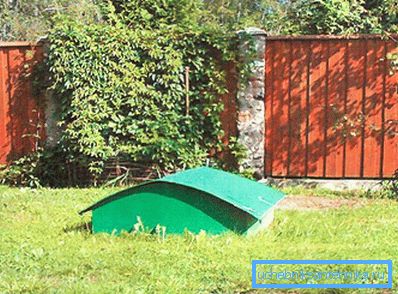Pass a septic tank for giving
Currently, factory-made septic tanks are in great demand among private house owners. They are installed in country cottages, cottages, etc. They are a plastic container for wastewater treatment. The septic tank is easily installed, does not require special care and does not spread an unpleasant smell around, unlike the usual cesspool.

In retail outlets there is a huge selection of septic tanks, differing in size, price and quality. But not everyone can afford to install such a unit to the cottage. It is about the cottage with a small plot of land. Yes, and living people in the house only 1-2 people, and then only in summer. It makes no sense to install a large septic tank, and the cesspool does not want to litter its already small area either. Therefore, specifically for such needs were released mini septic tanks for the garden. They are distinguished by compactness, ease of installation and reasonable price. In this article we will look at some models of septic tanks, which septic tank is better to choose, how and where to install it on your site.
Model selection

Basically, all models of mini-septic tanks are made of durable plastic, characterized by frost resistance. Despite the good quality, they have a fairly low cost. Consumer presented a huge number of choice of models and manufacturers. But all of them are divided into three types. Let's take a closer look at each of them separately, in order to have an idea of how to choose the appropriate model.

- The first type of models of mini-septic tanks, which we consider - universal. These mini-septic tanks have high performance - 0.5 m3 per day, which can provide wastewater treatment from the dwelling, where six people live. In the process of independent work, the universal mini-septic tank does not require consumables. As for its value, of these three types, it is the highest. The universal mini-septic tank has its own minus, which is difficult operation. This is due to the installation of additional three settlers, without which the system will not function properly. With regular use of the system, the sumps should be cleaned once a year.
- The second type of mini-septic tank models are designed for small cottages with infrequent visits to people. They are called - the mini-septic tank of the day off. Their low price is directly proportional to the small performance, which is 120 liters per day. The minus of this model is only a small performance due to the small size of the receiving unit.
- The third type of mini-septic tank models is ideal for installation in summer cottages, where 4 people live. From here he got his name - country toilet. The body of such models is made of anti-corrosion material, and has a low weight. In work differs in profitability. With the installation of problems in general will not. Having a small size, you can install it yourself anywhere in the summer cottage. The country toilet is the most successful model and practically has no minuses in use.
Installation of a mini septic tank

So, you have decided on a mini-septic tank model suitable for your site. We purchased it, and now you need to install a septic tank. As mentioned above, due to the small weight and compactness of the product, installation can be performed independently. Let's look at how to install a mini septic tank on its own.

- Installing a septic tank begins with digging out a pit and trenches for connecting a pipeline. It is necessary to dig two pits. You dig out the first ditch for the unit. It should be 40 cm in all directions more than the septic tank. You dig out the second ditch for an infiltrator. The sides of the excavation should be 40–50 cm larger than the infiltrator itself.
- From the exit and entrance of the septic tank digging trenches for connecting sewer pipes. The bottom of the trench should have a slope of 2 cm per linear meter, and a sand pillow of about 10 cm.
- The bottom of the pit for the septic tank fall asleep with sand about 30 cm and tamp. On the finished pillow install the unit itself. When installing the tip on the nipples. The inlet should be located in the direction of the trench, with sewers leaving the house.
- The bottom of the second pit is covered with rubble about 50 cm high. On the rubble pillow install infiltrator. Pay attention also to the location of the pipes in relation to the trench.
- After completing the entire installation, connect the septic tank to the infiltrator pipe system, in accordance with the manufacturer's instructions for your model. Connect the sewer inlet and outlet of the septic tank.
- Test the system by draining the water from the house into the sewer system. If everything went well, and the flow did not appear anywhere, proceed to backfilling the pits.
- Fill the system with layers of 30 cm, at the same time filling containers with water so that the ground pressure does not crush the plastic walls. You can fall asleep with a dry mixture of 1 part cement and 6 parts sand. Each layer is rammed.
- The manhole and ventilation pipe of the infiltrator should protrude 30 cm out of the ground.

This is where the work can be considered complete. Your mini system is ready to use. As you can see, it's pretty easy to do it yourself. Above all, do not forget to carry out the maintenance of the mini-septic tank during the work process and carry out regular cleaning of the containers.
Video
This video describes how to choose a septic tank for home and garden: